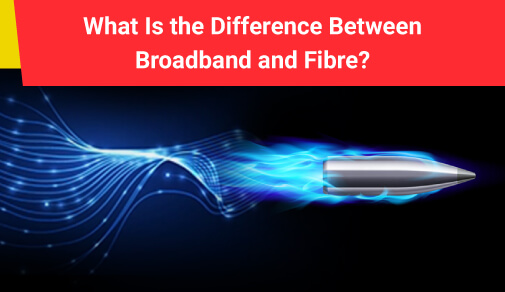Is broadband and fiber optic the same?
-
970
-
30 May 2022
-
3 minutes

Broadband speed is just as significant as having access to the internet in the first place. You may have a wifi connection, but it will be useless if it is not fast enough. There are numerous factors that influence your internet speed. The type of internet connection you have is at the heart of all of these factors. It is not your internet plan, router, or firmware, but the type of fibre connection you have. There are now two types of broadband internet connections: fibre optic broadband and traditional broadband connections.
What is Broadband?
Broadband is commonly used to describe high-speed Internet access that is always on and faster than traditional dial-up access. Broadband includes a variety of high-speed transmission technologies, including:
DSL (Digital Subscriber Line) Cable Modem Fiber Wireless Satellite
Powerline-based broadband (BPL)
The broadband technology you select will be determined by a number of factors. These may include your location (urban or rural), how broadband Internet access is packaged with other services (such as voice telephone and home entertainment), price, and availability.
What is Fiber Optic?
Fiber optics transmit data as light waves, or photons, that signal through a fibre optic cable. Each of the glass fibre core and cladding has a different refractive index, which bends incoming light at a different angle. Fiber optics transmission may necessitate the use of repeaters at regular intervals to renew or boost the signal throughout its journey. The optical signal is regenerated by these repeaters by converting it to an electrical signal, processing that electrical signal, and retransmitting the optical signal.
Fiber optic cables can now support signals of up to 10 Gbps. Generally, the higher the bandwidth capacity of a fibre optic cable, the more expensive it becomes.
What Is the Difference Between Broadband and Fibre?
Broadband is a type of internet service that provides its customers with high-speed internet access. Broadband is capable of sending multiple signals over a wide bandwidth. Broadband uses optical fibre, coaxial cable, twisted pair, and radio as its medium. It can be used by organisations as well as by individuals. The fibre cables used in fibre optic are used to transmit data through them. Superfast broadband is quicker than standard broadband, and the connection is also more reliable.
Factor
Broadband
Fibre
Network
In normal broadband, the copper circuits are used.
In fibre type broadband, fibre optic cables are used for sending the data. The hybrid fibre connection uses the copper wires.
Reliability
The broadband connection is less reliable compared to fibre broadband.
The fibre broadband is more reliable when it is compared to a broadband connection.
Speed
The broadband connection is fast speed internet, but the speed is slower when it is compared to a fibre connection.
The fibre broadband connection is very fast speed internet as it uses optical fibre for transmission of data. The fibre broadband is faster than broadband connection.
Cost
The cost of broadband setup is comparatively less to a fibre broadband connection.
The fibre connection is not so cost-effective as the fibre cables are costlier, increasing the cost of fibre connection setup.
Final thoughts:
With changing times, everyone has a need for high speed and credible internet service, and there are several options for broadband internet in the industry. Both broadband and fibre connections are convenient options for providing users with high-speed internet. The choice between the two is entirely dependent on the user's requirements and needs.






